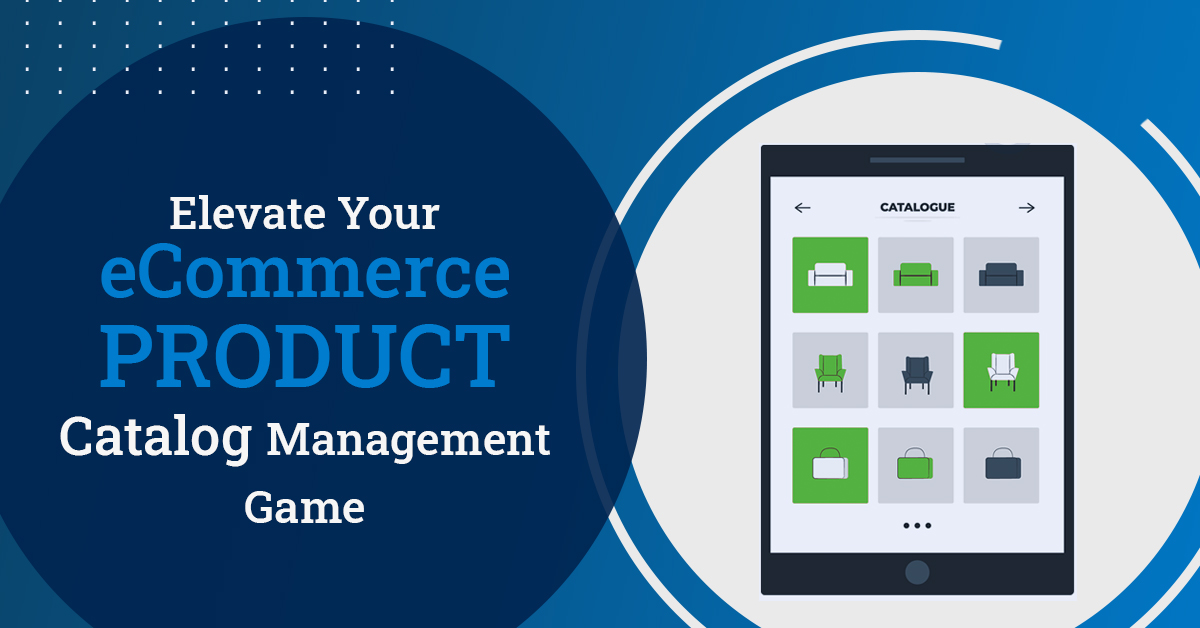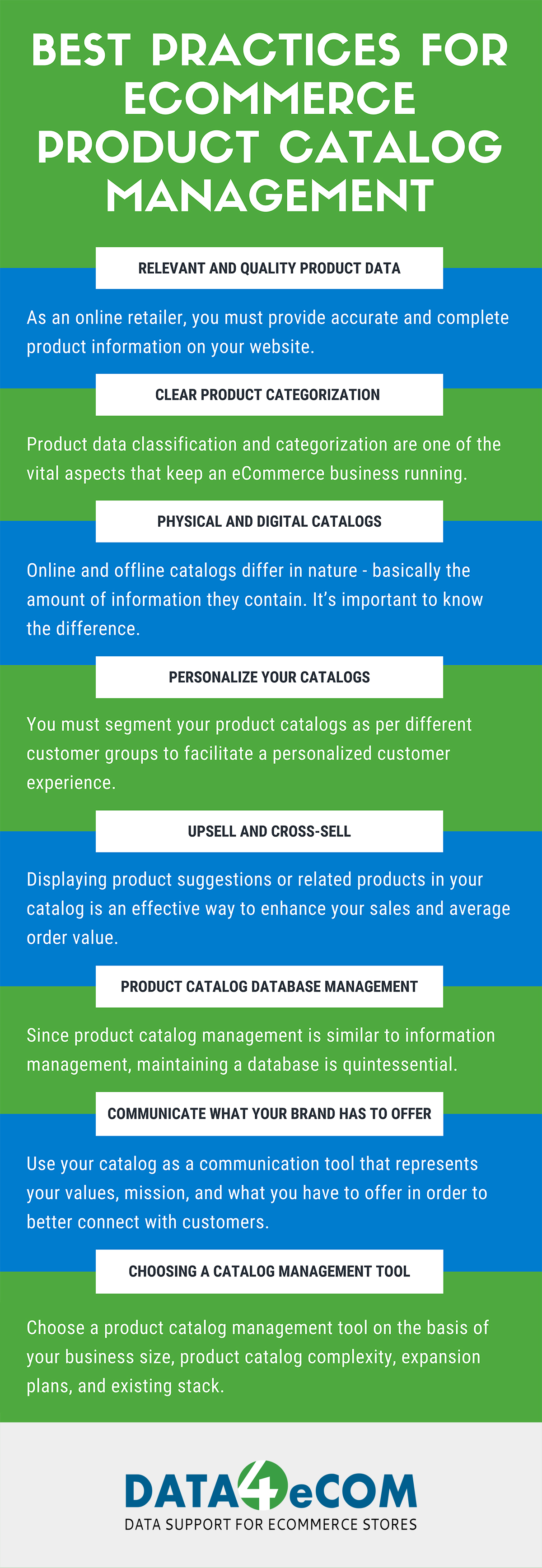
No wonder, eCommerce has gained traction over the past few years – thanks to the constant enhancements in technology and increase in consumer demand. Today consumers, across the globe, prefer to carry the majority of the activities online. From ticket reservations to buying clothes to paying bills, the shift from offline to online is apparent.
Businesses, on the other hand, have to stay parallel with the customers’ needs in order to serve them better and stay relevant. This not just means providing high-quality products/services but the right product information at all times. After all, no business would want to lose its customer to its competitor due to improper eCommerce product catalog management.
Now, before you surround yourself with questions of all sorts, we’d jump straight to what an eCommerce product catalog is all about.
eCommerce Product Catalog: Everything You Need to Know
What is an eCommerce catalog?
In general terms, a product catalog is equivalent to collateral that is used in sales and marketing to help buyers make a purchase decision. Talking about eCommerce in particular, a product catalog serves as an effective tool used by businesses to showcase their product offerings and drive sales. It carries the minutest details of all the products lying on your shelves while ensuring the product information such as prices, descriptions, images, etc. is accurate as well as up-to-date. This, in turn, allows visitors to have thorough product knowledge and make a smart buying decision.
Now that we know the online catalog has a huge influence on the decision-making process, it must be meticulously managed so that product data is accurate, updated, and convincing. This is perhaps the reason why the majority of businesses outsource eCommerce data entry services.
Why is it important to manage product catalogs?
Indubitably, product catalogs play a pivotal role in improving the customer experience, both online and offline. However, the real power lies in their ability to improvise product vibrancy and vividness for consumers to better visualize products. They, further, hone the usage experience of products, making them influential enough to attract buyers and convince prospects.
- Promotes a seamless user experience
- Improves overall productivity and operations
- Take on new growth avenues and opportunities
- Improve conversion rate
- Enhance Branding
What challenges does product catalog management bring?
Manual product catalog management is a tedious and cumbersome task. Enterprise, are often, found facing numerous challenges while managing their product catalogs, including:
- Multiple Stakeholders: When there’s a lot of information coming from multiple stakeholders, both inside and outside the organization, managing and updating your product catalog can be quite complex and time-consuming.
- Usability: All the internal product data must be properly converted for customers and users. If not, issues related to product display and categorization might arise and ultimately lead to bigger problems.
- Product Catalog Expansion: Your product catalog growth and business growth go hand in hand. An inaccurate and unorganized product catalog might adversely impact your business by eating up a major chunk of your time and efforts.
- Complex Product Details: Depending on your niche, some products might have complex details, as compared to others, which must be incorporated in a way that can easily be understood by customers at the time of buying.
- Choosing a Catalog Management Tool: This requires you to choose a tool in line with your business requirements and then indulge in the know-how of the chosen tool.
In absence of the right eCommerce catalog management strategy, your product data will be inconsistent and all over the place. Further, your operational productivity, data quality, and business revenue might be greatly affected. On the other hand, an effectively managed eCommerce catalog can set the foundation for a good user experience, enhance SEO, improve site navigation and give customers the confidence to buy.
To help you overcome the challenges of catalog management, we’ve got together a list of practices that will help you manage your product catalog in the best possible way. Let’s dive in.
Best Practices for eCommerce Product Catalog Management

Relevant and Quality Product Data
As an online retailer, you must provide accurate and complete product information on your website. This includes everything from technical attributes, high-resolution images/videos, units of measurement, product usage to features, and more. This, in turn, helps potential customers in navigating through your website seamlessly while building trust and facilitating the buying decision. The information must be both updated and comprehensive for you to have an accurate product catalog and optimized user experience.
Clear Product Categorization
Product data classification and categorization are one of the vital aspects that keep an eCommerce business running. A well-designed product catalog must have precise and clearly defined product specifications including size, color, price tags, etc. All these, along with other relevant specifications/attributes, must be smartly added to your product description to promote a flawless user experience and enhance search relevancy. With diverse products belonging to diverse categories, categorization and classification become essential to a well-maintained product catalog.
Physical and Digital Catalogs
As you might know, online and offline catalogs differ in nature – basically the amount of information they contain. A physical (offline) catalog, on one hand, contains a lot of added information, whereas, digital (online) catalog, on the other, only has precise information. In addition to this, the audience for both catalogs behaves differently, thus making it essential for you to work parallelly with your customer’s behavior while delivering instinctive product values.
Personalization
Serving the same things to different audiences is a no-no when it comes to selling online. Thus, personalizing your product catalog for different customer segments is vital. In case you are a B2B organization, you might have to deal with added complexity where your product pricing can vary for different customer/order groups. Therefore, you must segment your product catalogs to facilitate a personalized customer experience.
Upselling and Cross-Selling Techniques
No wonder, displaying product suggestions or related products in your catalog is an effective way to enhance your sales and average order value. For instance, if a customer is looking for a mobile, you could suggest a cover or screen guard to go with it. Another technique is to suggest an alternative product – with better features and quality. This, in turn, not only encourages the buyer to browse until they have found the right product but builds trust and upscales your sales chart.
Product Catalog Database Management
Since product catalog management is similar to information management, maintaining a database is quintessential.
- Maintain a single database to keep all the information in one place. This avoids data duplication and prevents all kinds of errors. You can also leverage customer data deduplication services from a trusted product catalog management vendor.
- If you are planning on product expansion, assess the feasibility of your database expansion.
Communicate What Your brand Has to Offer
We have already mentioned the role product catalogs play in convincing customers to make a purchase. Use your catalog as a communication tool that represents your values, mission, and what you have to offer in order to better connect with customers. Further, modify the look and feel of your catalog to match your brand’s theme. Use elements, besides product images and features, that engage customers and start a conversation with them while helping them make better purchase decisions.
Choose a Catalog Management Tool
There are several eCommerce product catalog management tools available in the market. Depending on your business requirements, you can manage the product catalog through:
- Independent eCommerce platform
- Spreadsheet software
- Product information system (PIM)
- eCommerce platform with ERP integration
When choosing a tool, make sure you consider your existing tech stack, business size, catalog complexity, resource availability of resources, and expansion plans.
Over and Out
After going through the guide, one thing that’s certain is: the success of your product catalog management is directly proportional to your business success. Now since there’s no-one-trick-that-fits-all, you have got to follow certain tried and tested strategies to crack product catalog management.
In case you need further assistance in handling your product catalog and are considering outsourcing to a trusted partner, Data4eCom can help you considerably. From catalog content management to product description writing to eCommerce catalog updating services to bulk product upload, we provide a comprehensive range of product catalog management to keep your product catalogs updated and managed at all times.


